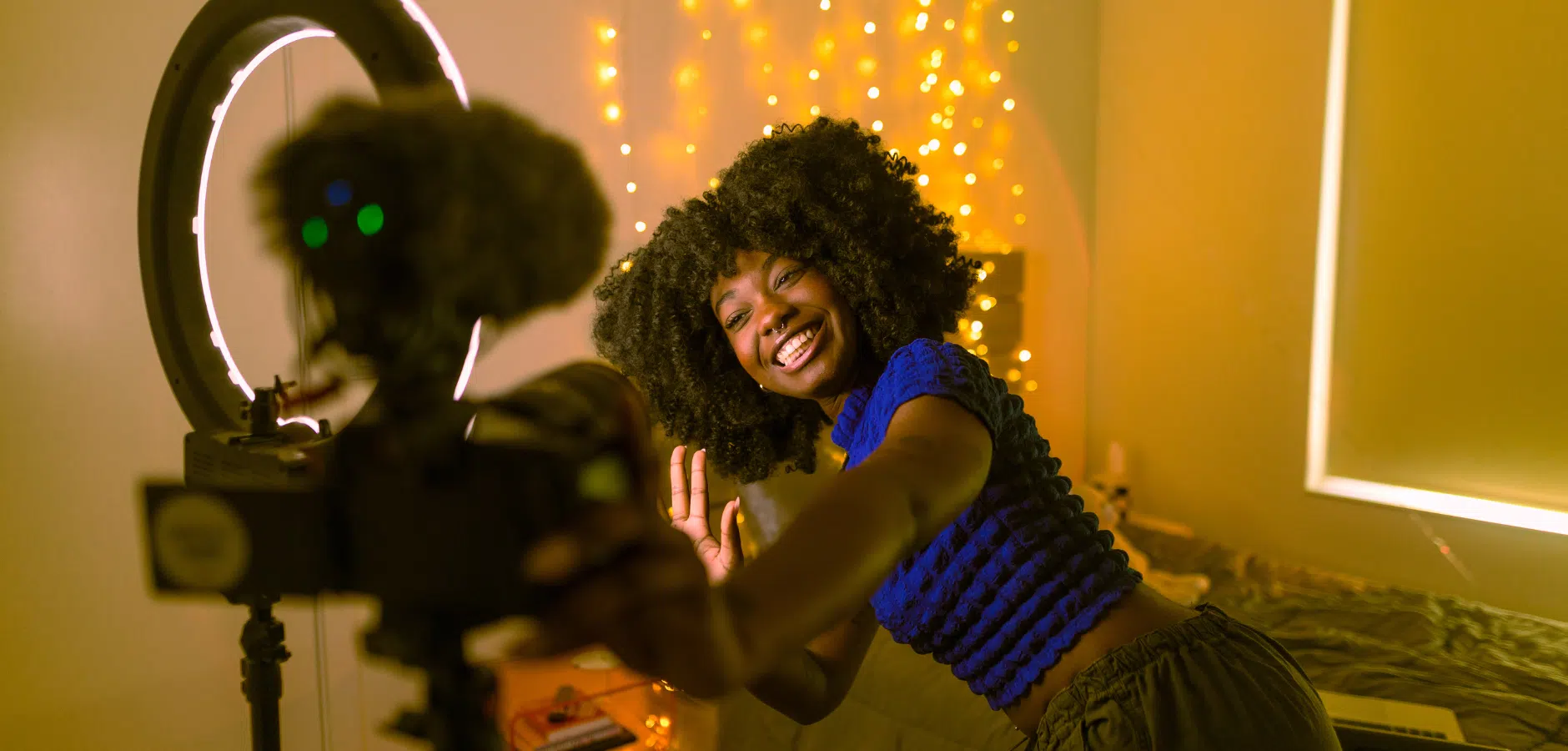As a marketer, you face a complexity problem: TikTok algorithms reward authenticity, Instagram drives conversions through Stories, and YouTube builds trust through long-form content. Managing creator partnerships across these platforms requires more than scaling the same approach—it demands a platform-specific strategy.
More than half of consumers now purchase directly through social platform shopping features, making multi-platform creator partnerships essential for reaching audiences where they actually convert. But success depends on matching the right creator, content format, and messaging to each platform’s unique strengths.
The challenge isn’t finding creators who post everywhere—it’s finding those who understand how to adapt your brand message to each platform’s culture while maintaining consistency.
This guide breaks down how to build creator partnerships that work across platforms, based on insights from impact.com’s creator services team, who manage these programs daily for brands across industries:
- How to select creators based on platform-specific performance, not just follower count
- How to maintain brand consistency while allowing creative freedom across channels
- How to measure cross-platform attribution and optimize budget allocation
Whether you’re launching your first creator program or scaling an existing one, the strategies ahead focus on what drives measurable results, not just engagement.
The multi-platform complexity challenge: Why one-size-fits-all doesn’t work
The biggest mistake brands make with multi-platform creator partnerships? Treating all platforms the same.
A TikTok video that goes viral might flop on Instagram. An Instagram Story that drives conversions could feel forced on YouTube. Each platform rewards different content styles, timing, and engagement approaches—and the algorithms change constantly.
This creates a strategic challenge: How do you maintain consistent brand messaging while adapting to each platform’s unique demands? The answer lies in working with creators who understand these nuances, not just those with the biggest follower counts.
Here’s why platform-specific creator strategies deliver better results than broad-reach approaches:
Expand your brand: Connect with audiences on the right social platforms
Each social media platform operates on its own logic, and platform demographics vary significantly. Elin Andersen, Influencer and Creator Manager at impact.com, explains that “TikTok attracts a younger crowd, while Instagram caters to a more mature audience,” noting that creators often use both platforms for different purposes.
This distinction is critical for brands focused on cross-platform audience expansion. It means your message needs to shift depending on where it’s being delivered—not in what you say, but in how you say it. Uniform content doesn’t support a strong creator partnership portfolio.
A strong multi-platform creator partnership matches platform to purpose. If you’re targeting younger demographics with trend-driven content, TikTok’s where that conversation starts. If your message needs space for product education, YouTube delivers. Instagram can bridge the two with visual content that’s both aspirational and shoppable.
This is how creator platform diversification works in practice. The creator understands the room, and you show up with content that makes sense for the setting.
Adapting content to platform culture keeps your brand consistent without sounding repetitive
The best creators know that tone, pacing, and delivery must adapt to fit each platform. Instead of forcing the same format everywhere, they tailor their content to suit the unique style of each channel. According to Micaela Abrahams, Senior Campaign Manager at impact.com, YouTube excels as a platform for long-form storytelling, while TikTok thrives on short, trend-focused content.
This level of awareness powers platform-specific creator strategies, and it’s how you maintain consistent brand messaging without sounding scripted—which is ultimately what makes content feel native to each platform
Content creators who tailor their work to each platform earn more trust, engagement, and response.
Nearly half of audiences worldwide connect with authentic content, second only to pure entertainment. It’s a reminder that multi-platform creator partnerships work—they prioritize relevance. Showing up in ways that feel real earns attention.
A multi-platform strategy mirrors how people actually consume content
People interact with content differently, depending on the platform. Some scroll for quick inspiration, while others click in for context or depth. A multi-platform strategy allows you to cater to these varied behaviors without relying on a single format to do all the work.
Claire Taylor, Senior Campaign Manager at impact.com, highlights the benefits of a multi-platform approach. She explains that it allows brands to engage with various content consumption habits. For example, Instagram Stories are conversational, TikTok is quick and creative, and YouTube provides in-depth tutorials.
This insight shapes how you build creator partnerships. When creators plan content around audience behavior, they make messages easier to absorb, trust, and act on—with each piece fitting into a larger content strategy that guides people through different digital channels.
That’s how community building happens. The structure mirrors the behavior. As audiences move between platforms, your message moves with them.
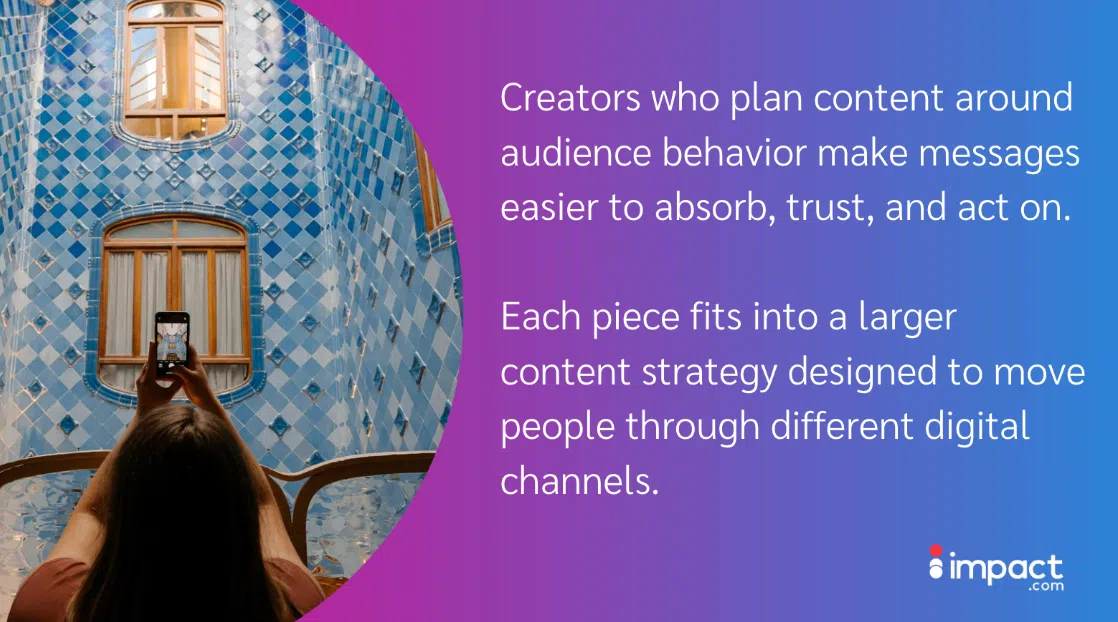
Strategies for selecting the best content creators
Now that you understand why platform-specific approaches outperform one-size-fits-all content, the question becomes: How do you find creators who can actually deliver this level of adaptation?
The answer lies in evaluating creators not just on follower count or general engagement, but on their ability to tailor content effectively across platforms while maintaining your brand message.
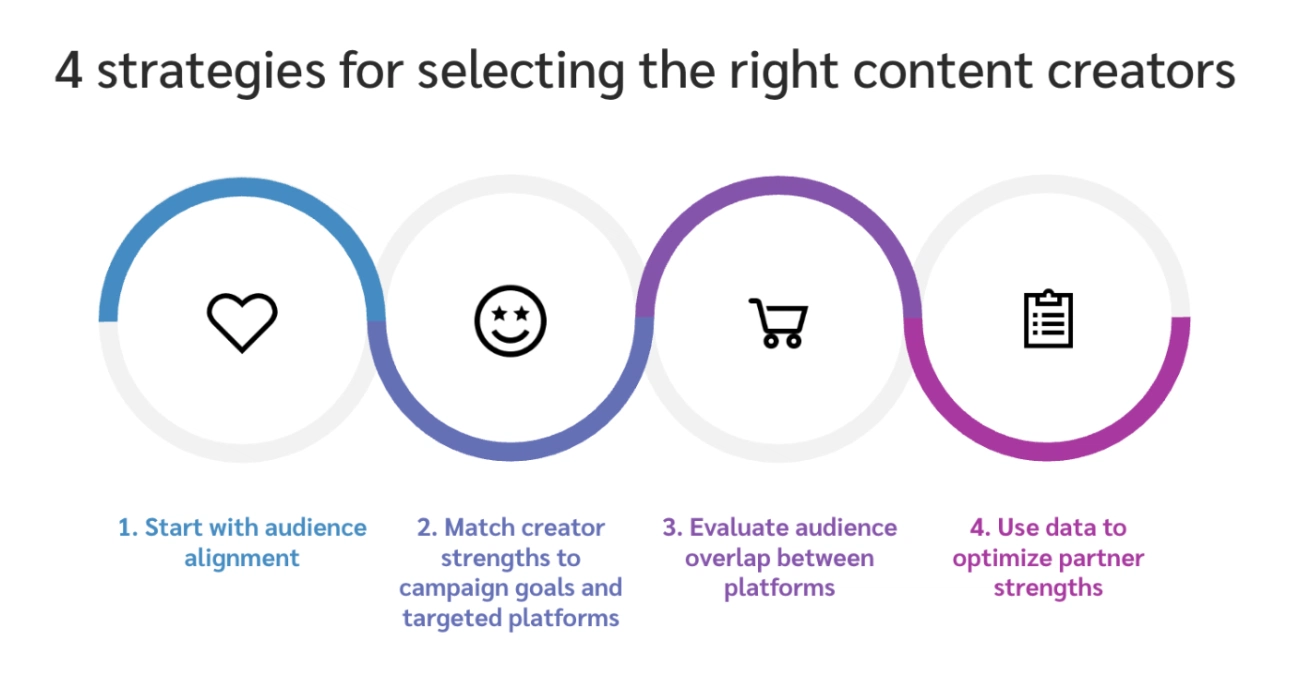
Start with audience alignment before choosing a platform
Begin by checking who the creator is reaching. Audience alignment is the most important filter when evaluating fit. If their followers don’t match your target, even great content won’t drive results.
“Contract creators whose audience demographic aligns with your target audience,” Abrahams advises. “This guarantees that the content resonates with the right people.”
This step also shapes your entire creator partnership portfolio. It informs what kind of content gets made, how it’s received, and where it should live.
Tools like impact.com’s Chrome extension and Slideout Profiles make this process faster. You can scan social media platforms, view audience and engagement data, and spot existing brand connections, all before making contact. It’s a simple way to prioritize platform-specific creator strategies based on real data.
Match creator strengths to campaign goals and platform roles
Each platform supports different outcomes. Some drive engagement, others drive sales. Adams explains that brands should focus on their goals—whether it’s awareness, conversions, or engagement—and select the platform accordingly. She notes that Instagram works well for sales because of story links, while TikTok is ideal for organic engagement.
This kind of alignment helps you set expectations and define what success looks like. Here’s how to break it down:
- If your goal is awareness: TikTok and YouTube Shorts offer reach, trend potential, and discovery through user-generated content (UGC).
- If your goal is conversions: Instagram Reels and Stories support shoppable links and retargeting.
- If your goal is education or trust-building: Long-form YouTube videos are ideal for deep product demos and storytelling.
Effective multi-platform partnerships match the best content to each platform, guided by clear goals.
Evaluate audience overlap to shape your reach strategy
Some creators reach different followers on every platform. Others speak to the same audience across channels. Knowing which type you’re working with can shape your entire creator partnership portfolio.
Taylor explains how brands can optimize their strategies and strengthen partnerships, advising, “Determine whether your goal is to deepen your reach or broaden it. Some creators can achieve both, depending on the strength of their platform presence.”
This decision shapes how your message travels. Do you want to reach new segments or reinforce brand familiarity through repeated exposure and audience engagement?
To make that call, tools like impact.com’s Social Listening feature offer a shortcut. You can identify creators already talking about your brand. This signals alignment with your values and the ability to deliver authentic content across platforms.
Use data to evaluate where creators perform best
Effective creator selection starts with performance data. You need to know where each creator delivers the strongest results.
Assigning content based on those strengths leads to:
- Better performance
- Stronger audience engagement
- Cleaner attribution
- Less wasted spend
When you understand these benefits, you can dig into platform-specific performance in detail. It also helps you see the difference between engagements and conversions more clearly.
Prioritize platform-specific performance
A strong multi-platform strategy runs on numbers. The more precisely you track performance, the easier it is to match the best content to each platform.
Analyzing creators’ performance metrics across different platforms can help maximize the impact of campaigns. By assigning deliverables to the platforms where each creator excels, brands can ensure content resonates with the intended audience and drives better engagement.
As Konneh points out, this data-driven approach is a great way to achieve maximum ROI and build long-term creator partnerships.
Creators already have patterns—content types, timing, and platforms where they drive results. Assigning content based on those strengths leads to better performance, stronger engagement. cleaner attribution, and less wasted spend.
Separate engagement from conversions
Each platform plays a unique role in the buyer journey. “Sales are often best on Instagram, while TikTok excels in organic engagement,” Anderson reveals. Understanding these nuances helps brands allocate resources effectively.
Campaigns hit harder when creators are matched to the outcomes they deliver best. Using real-time data to track performance mid-campaign means you can adjust your budget, reassign creators, and course-correct while there’s still time to make an impact. impact.com’s Performance by Platform feature helps you spot what’s working and go deeper where results are strong.
Managing creators for success: Balancing direction with creative freedom
Once you’ve chosen the right creators, the next step is managing them so that both sides will win.
That means maintaining brand consistency while allowing creators to speak in their own voice. When done right, this leads to content that sounds natural and connects more directly with audiences. These types of authentic endorsements influence 34 percent of consumers worldwide to make a purchase.
The best creator relationships are built on clear collaboration, shared goals, and trust in the creator’s delivery.
Trust creators to know their audience
Allowing content creators to shape your message through their own voice leads to authentic and intentional content. It resonates more deeply with audiences because it’s crafted by someone who truly understands them. Creators know what their followers expect—whether it’s tone, format, or style.
Adams emphasizes the importance of giving creators the freedom to adapt brand messages. Why? Because they know their audience best. By trusting their expertise and creativity, brands can foster stronger connections and build impactful multi-platform partnerships. The result? Messaging that feels genuine and leaves a lasting impression.
A flexible approach works best. Provide examples of successful past messages and allow creators to interpret them in their own way. This method helps align content with brand goals while ensuring it remains culturally relevant across different social media platforms. Abrahams advises brands to move beyond rigid scripts and allow creators greater creative freedom.
Provide clear guidelines without micromanaging
A clear brief is the foundation of a strong partnership. “Building customized campaign briefs for each platform guarantees message consistency, while giving content creators enough room to adapt in their unique voice,” Konneh explains.
Strong briefs define brand messages, platform-specific content formats, and clear do’s and don’ts. From there, creators can tailor the message to their audience and style without veering off-brand.
Brands can host kickoff sessions to align teams. These short calls focus on tone, brand nuances, and expectations, creating a foundation of trust and clarity. Adams notes that such sessions not only encourage thoughtful execution, but also help creators feel supported throughout the process.

Collaborate for long-term success
Strong creator partnerships grow through consistency, clear communication, and mutual respect. If you commit to the relationship, you’ll see better performance across platforms and content formats.
Longer collaborations deliver better results
Familiarity fosters fluency, enabling creators to effectively communicate your brand’s message across various formats.
Longer-term collaborations are key to achieving this. Adams notes that these partnerships cultivate deeper trust and mutual understanding, ultimately leading to stronger brand integration and greater authenticity over time. This is the foundation for building scalable, lasting relationships with creators.
Review scripts before filming
Review scripts early to save time and avoid unnecessary reshoots. Making a few edits upfront is far simpler than reworking a finished video, and it ensures a smoother production process.
For video creators, this approach demonstrates respect for their time and workflow, leading to stronger results. As Andersen points out, early collaboration on scripts benefits both sides and sets the stage for a more efficient, successful project.
Build concepts together
Partnering with creators is a powerful way to maintain consistent brand messaging while fostering creativity. It enables brands to reach wider audiences across platforms by adapting messages effectively to each channel and format.
Brands should collaborate closely with creators to develop concepts together. Taylor expands on this, adding, “While it’s important to control the core message, brands should allow creators to express it in their unique voice.” This balance ensures authenticity and engagement, driving stronger connections with your audience.
Expanding audiences through platform diversity
With your creators in place and clear guidelines established, here’s how to optimize your content for maximum impact across platforms.
Leverage platform-specific strengths
Each platform serves a unique purpose. Leading brands create content that aligns with each platform’s strengths. Think of platforms as puzzle pieces that come together to build a larger brand story. Consumers get to have fun putting that story together.
Multi-platform storytelling keeps audiences engaged. It also helps build stronger, more meaningful connections.
Creators can craft these storytelling arcs in various ways: tease content on TikTok, dive deeper on YouTube, and follow up on Instagram Stories. Taylor explains that this approach keeps audiences engaged across multiple touchpoints, creating a cohesive narrative that resonates across channels.

Encourage cross-promotion
Cross-promotion is a powerful way for brands to extend the life of their content and connect with new audiences.
Encouraging creators to share branded content across multiple channels can significantly increase exposure to diverse demographics. This approach not only maximizes reach but also ensures content stays relevant for longer. As Abrahams highlights, this strategy amplifies the impact of any campaign.
This ensures that content works harder for the brand by leveraging formats that resonate most with audiences. Short-form content, in particular, is easy to cross-promote and is the most loved, connecting with 63 percent of audiences globally.
Measuring performance: Metrics that matter
Data is a decision-making tool. It shows you where to double down, when to pivot, and how to scale. But only if you’re tracking the right things.
Think beyond vanity numbers. Views and likes are easy to inflate. Metrics like conversions, click-through rates, engagement quality, and platform-by-platform sales tell you what’s actually driving growth.
The goal is to stay sharp. Every creator performs differently across platforms, and every campaign carries its own learning curve. Using data, you can spot what’s working and steer the rest.
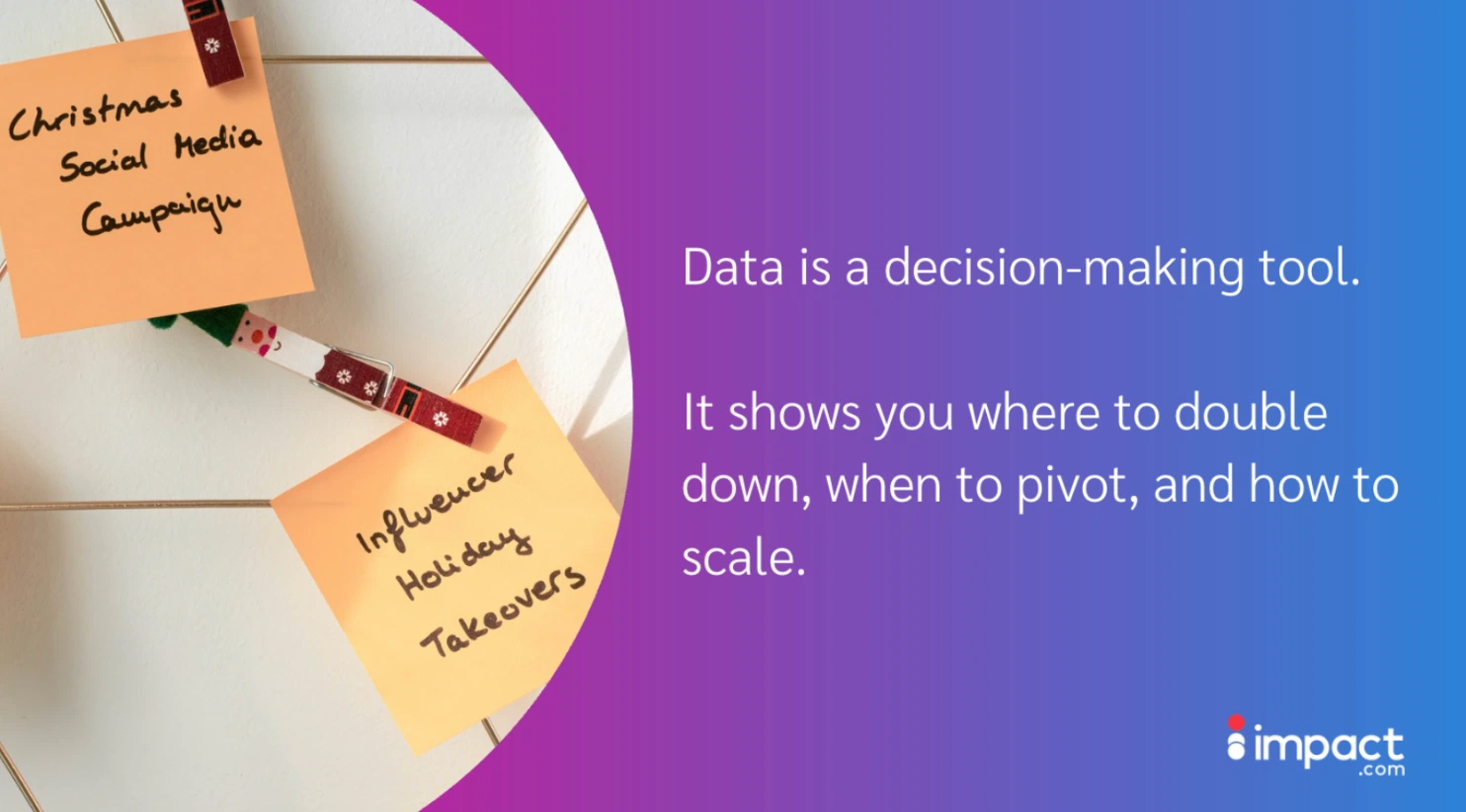
Audience growth and reach
Track where your campaigns bring in new eyes.
Measuring unique reach, or the number of new users engaging with a creator’s content, is an important metric for brands. This helps track how many new users interact with the content, not just existing followers. Konneh adds that tracking unique reach reveals which digital channels successfully expand visibility and attract attention beyond the core audience.
Traffic tells a similar story: Use unique links to monitor which creators or social media platforms are driving site visits. New site visitors from a platform indicate a growing, interested audience beyond just social follows. Konneh explains that these signals highlight cross-platform audience expansion and help identify where momentum is building.
Engagement and content performance
Some content takes off, while some lingers. Tracking engagement rates across platforms and comparing them to the creator’s typical output can help identify what’s working.
Taylor recommends tracking engagement rates across platforms and comparing them to the creator’s typical output. “Track engagement across platforms to see where the audience is most receptive,” she explains. “Compare these rates to the creator’s usual content to gauge effectiveness.”
This approach helps determine which messages resonate and which ones need reworking.
View rates add another layer. Measure how many followers actually watch the content. This is especially important for video creators whose reach may be inflated by algorithms, but whose engagement tells the real story.
Conversions and ROI
Sales activity shows where your content is resonating. Use these signals to guide your creator platform diversification. Each platform plays a different role in your funnel.
To get a full picture, look at customer acquisition. Are you reaching new buyers or recycling the same ones? Comparing first-time customers with repeat ones helps sharpen your cross-platform attribution model and shapes how you invest going forward.
Sentiment and brand perception
Metrics show you what happened. Sentiment shows you how it landed.
Comments tell you more than like counts. Look for patterns, tone shifts, and repeated language across platforms.
Tools like impact.com’s Social Listening feature let you monitor what audiences say in comments and discussions. This feedback can help brands adapt messaging and address audience pain points in future content.
This is where message adaptation strategies meet the real world. In the replies and comments, not the reports. Track how audiences respond in their own words. This a vital signal for audience engagement.
Multi-platform strategies in action
impact.com’s creator team has helped brands grow their partnership programs into reliable, scalable systems. Glossier and Ellos are two examples of how platform-specific campaigns and thoughtful creator relationships can expand audience reach and drive measurable results.
Glossier: Building reach through thoughtful creator content
Beauty brand Glossier works with a mix of paid and gifted creators who understand the assignment—to expand reach while staying within budget. This gives the brand flexibility to collaborate with a range of partners who each bring their own audience and content style.
Instagram content focuses on:
- Polished product photography
- Short Reels featuring everyday use
- Story posts with real-time tutorials and swipe-up links
TikTok is used to:
- Cross-post Reels from Instagram
- Extend reach with minimal extra work
On YouTube, creators produce:
- Long-form tutorials showing product application
- Conversational videos that explained product benefits in more detail
By tailoring the content to each channel, Glossier has maintained brand consistency while increasing visibility. Their creator partnerships help build steady momentum across platforms and open up new revenue streams through repeated exposure and platform-native content.
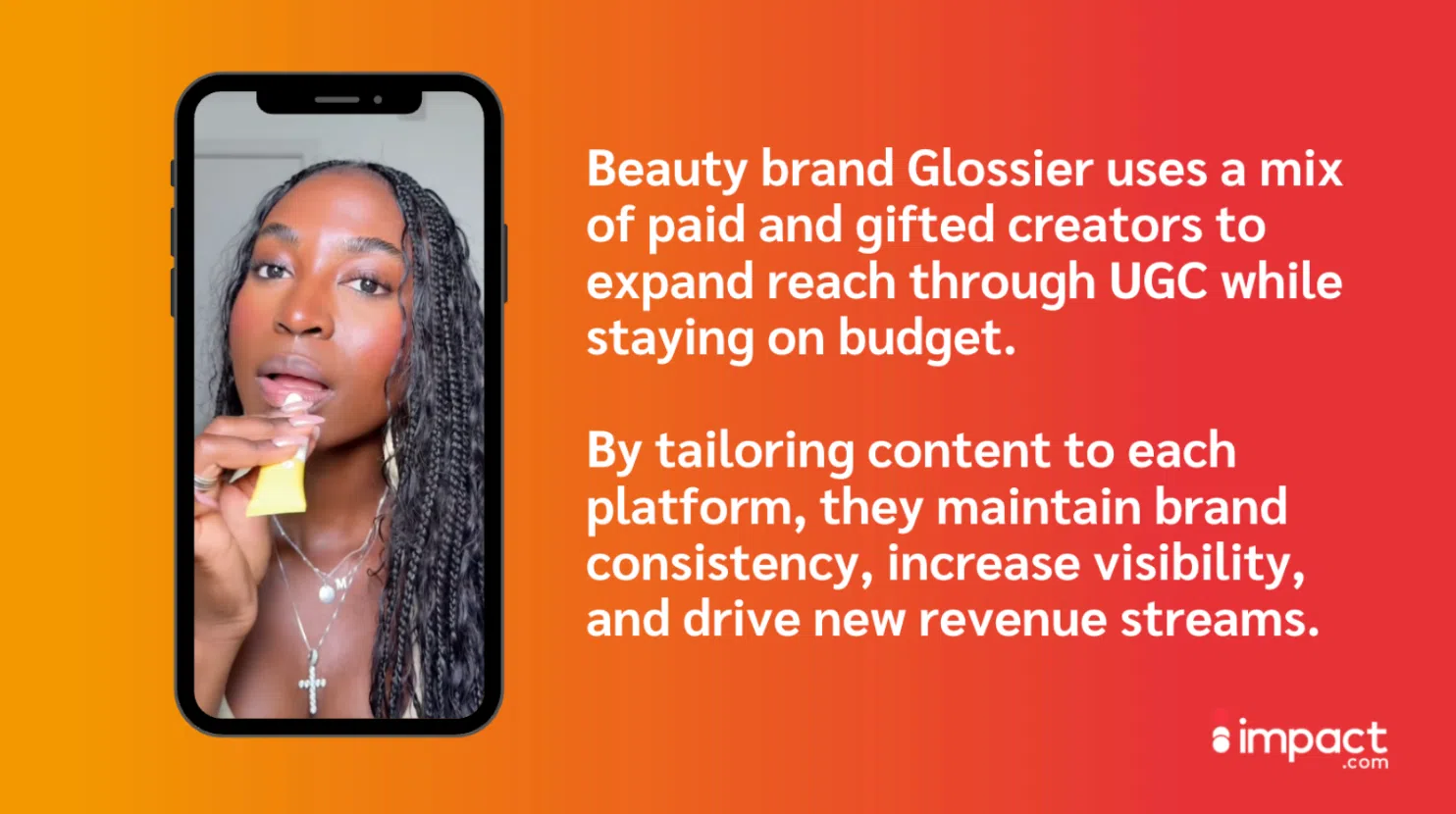
Ellos: Reaching younger audiences through creator testing
Leading fashion and home brand Ellos historically focused on a mature, middle-aged customer base. But their data showed untapped potential across other age groups. To expand their reach, the team launched a series of creator-led campaigns through the impact.com platform.
One of their key partners was Natasha Høyer, a younger creator with strong traction on TikTok.
With Natasha, the team:
- Ran multiple campaigns tailored to her audience
- Saw strong engagement from users under 25
- Built brand recognition in a demographic previously outside their core target
During the Autumn/Winter 2024 campaign, Natasha became the brand’s top-performing creator. Her content drove high conversion rates, even on a platform where conversions weren’t the usual focus for the brand. The campaign helped Ellos see who was paying attention and how to speak to them—a clear case of message adaptation strategies meeting evolving algorithm changes.
By tracking performance and staying open to new formats, the team unlocked a different kind of growth, one shaped by creators and refined through results.

FAQs
A multi-platform creator is someone who produces content and engages audiences across multiple social media platforms, such as TikTok, Instagram, YouTube, and LinkedIn. Working with multi-platform creators allows brands to reach diverse audiences, as each platform attracts different demographics and serves unique purposes. For example, TikTok often appeals to younger audiences, while Instagram tends to attract a more mature demographic. By partnering with these creators, brands can tailor their messaging to fit each platform and maximize cross-platform audience expansion.
To choose the right creators, start by aligning your campaign goals with the creator’s audience and platform strengths. If your goal is to drive sales, Instagram’s story links may be ideal, while TikTok is better suited for organic engagement. It’s also important to evaluate the creator’s performance metrics on each platform to ensure they are assigned deliverables where they perform best—supporting creator platform diversification. Additionally, consider whether the creator’s values and content style align with your brand to ensure authenticity and resonance with your target audience.
Consistency starts with clear guidelines and flexible briefs. Brands can maintain consistent positioning by establishing clear goals and structuring their strategy based on the platform. Providing creators with a brand voice guide that outlines tone, dos and don’ts, and platform-specific creator strategies is essential. Hosting kickoff sessions to align on expectations and build trust can also help ensure your message stays cohesive while allowing creators to adapt it authentically for each platform.
To measure success, track metrics such as unique reach to see how many new users are engaging with your content, and monitor traffic driven by creators using unique links. Engagement rates across platforms can help identify where the audience is most receptive, while conversions, including sales and clicks, provide insight into direct impact and growing revenue streams. Additionally, audience sentiment, gathered through social listening tools, can reveal how your brand is perceived and help refine future content scheduling and audience engagement efforts.
Balancing creative freedom with control requires collaboration. Brands should provide clear guidelines on tone, values, and non-negotiables, but allow creators the flexibility to adapt the message in their own voice. Instead of rigid scripts, offering examples of successful content can inspire creators while maintaining alignment with brand goals. Long-term partnerships are also effective, as they build trust and mutual understanding, leading to more authentic and impactful content across all social media platforms.
Making multi-platform creator partnerships work
Multi-platform creator partnerships work when brands stop treating content like copy-paste and start treating it like communication.
The strongest programs:
- Set specific goals for awareness, conversions, or audience engagement
- Choose the right content creators whose platform-specific creator strategies match the job
- Adapt brand messaging across social media channels (TikTok, YouTube, Instagram, and more)
- Use cross-platform attribution and content scheduling tools to stretch every asset further across digital channels
- Track data that matters—and adjust fast based on algorithm changes and creator platform diversification
This approach builds real traction. If you’re ready to sharpen your content strategy, schedule a demo and work with our creator services team to build your best creator partnership portfolio yet.
Check out more content to optimize your marketing strategy:
- Why consumers buy products from people, not brands [podcast]
- From affiliate to creator: How Vistaprint built a hybrid partnership program that drives revenue and brand awareness [blog]
- Building a successful influencer marketing program [worksheet]
- Search and partnerships: How to find and recruit partners for your affiliate and influencer marketing [ebook]
- Beyond promotion: How creators add value through authentic affiliate partnerships [blog]
